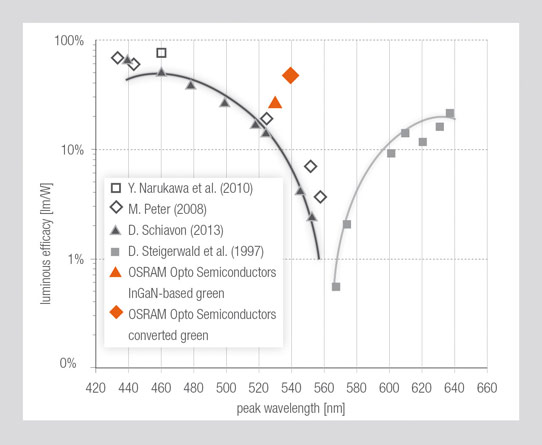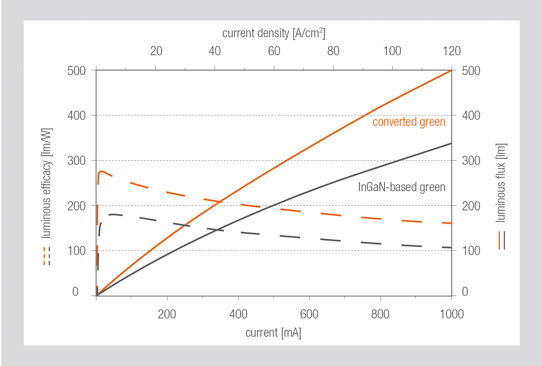- News
6 November 2014
Germany's Osram-led Hi-Q-LED project achieves record 147lm/W for 530nm all-InGaN green LED
Funded by Germany’s Federal Ministry of Education and Research (BMBF) and coordinated by Osram Opto Semiconductors GmbH of Regensburg, Germany, the Hi-Q-LED project has made advances with green LEDs, diminishing the ‘green gap’ phenomenon (the significant drop in efficacy in the green spectral range). The result is a green-emitting LED based on indium gallium nitride (InGaN) that achieves record luminous efficacy of 147 lumens per watt (lm/W) at a wavelength of 530nm and a spectral width of 35nm. In addition, another green LED developed by combining a blue chip with a phosphor converter has achieved record efficacy exceeding 200lm/W.

Picture: Efficacy drop of LEDs in the ‘green gap’ spectral range.
As part of the LED Lead Market Initiative funded by the BMBF, the working group for ‘Efficient LED Solutions with High Color Rendering Indices’ in the Hi-Q-LED project headed by Osram Opto Semiconductors has developed two green LED prototypes.
Green all-InGaN LEDs close ‘green gap’
Conventional LEDs show a significant efficacy drop in the green gap (wavelengths above 500nm). Research activities in the framework of the project have enabled the development of a narrowband green LED with record efficacy of 147lm/W for a chip size of 1mm2 and a driving current of 350mA (a current density of 45A/cm2). The LED has a central wavelength of 530nm and a forward voltage of 2.93V at this current density. Key factors behind the breakthrough were a reduction of the carrier density in the light-emitting layers and a significantly improved material quality.
Due to a significantly reduced dependency of the efficacy on the operating current compared to conventional green LEDs, the prototype shows greatly improved performance at higher current densities and achieves as much as 338lm at 125A/cm2. “InGaN-based LEDs, in which the light output is generated by an InGaN semiconductor exclusively, offer a much more narrowband emission with a spectral width of about 35nm compared to green LEDs that are based on phosphor conversion,” explains project manager Dr Andreas Löffler. “This breakthrough is an enabling technology for highly efficient projection systems requiring a high color rendering index (CRI),” he adds. “A high color rendering index or an increased color gamut means a more vivid, higher-quality image.”

Picture: Luminous flux and efficacy versus operating current for both InGaN-based green LED and a conversion LED.
Record efficacy of >200lm/W with green full conversion phosphor solution
The project’s second approach - to create a new, even more efficient green LED - comes into play in cases where the spectral bandwidth of the LED is not critical. Record figures demonstrated were 209lm/W (210lm) with a chip size of 1mm2, a central wavelength of 540nm, a forward voltage of 2.88V and a driving current of 350mA (a current density of 45A/cm2).
For a current density of 125A/cm2, it proved possible to boost the light output to above 500lm. Despite this high current density, the efficacy reaches 160lm/W. The efficacy peaks at 1.5A/cm2 with a maximum of 274lm/W.
The exceptional performance figures have been achieved due to the optimized interaction of chip and converter technologies, says Osram research engineer Dr Thomas Lehnhardt. “Continuous improvement of the blue LED chips, an optimized excitation wavelength and an increased degree of conversion of the phosphor converter are the winning combination underlying this new record-breaking LED,” he adds.
From prototypes to series production
At the moment, the figures achieved by the two LED prototypes still can only be ranked as development data. Further time will be needed to develop products based on the research project’s findings that offer optimized price and performance and are suited to mass production.
China’s San’an expands by ordering 50 Aixtron MOCVD systems
Veeco launches 31x4"/12x6"/6x8"-wafer EPIK700 GaN MOCVD system


